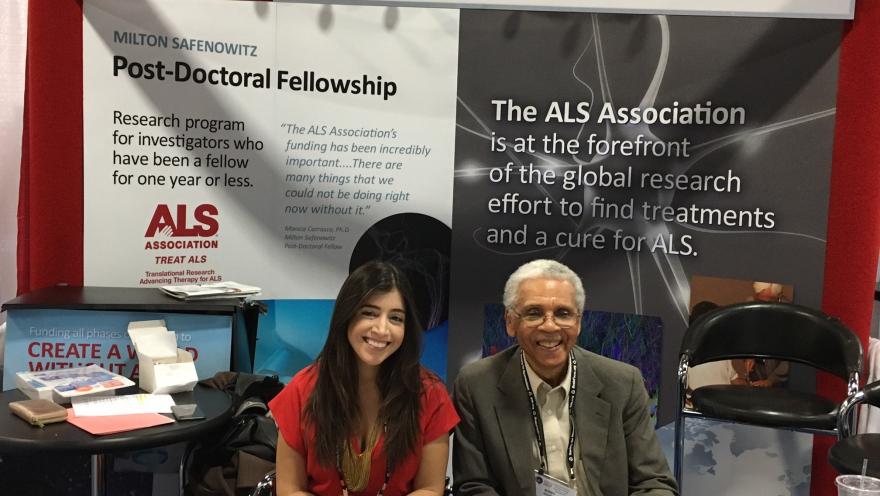This year’s annual Society for Neuroscience (SfN) Meeting in Washington, D.C., was a huge gathering of over 30,000 attendees from 80 countries all dedicated to advancing neuroscience. The ALS Association was one of 534 exhibitors and promoted our global TREAT ALS research program. We met people and answer their questions about ALS. Multiple presentation sessions and posters were dedicated to ALS and many of our funded researchers attended to present and discuss their latest findings. Here are some highlights of the many top ALS scientists that we fund who generously shared with us the progress they have recently made.
Here are some highlights of ALS Association-funded projects presented at the conference.
Lauren Sciences developed the novel V-SmartTM nanovesicle platform that can encapsulate non-brain penetrant therapeutics to allow crossing over the blood-brain barrier in the central nervous system (CNS). V-Smart Nanomedicine for the treatment of ALS – LAUR-301 – was designed to carry a neurotrophic factor (nutrient for motor neurons) to the CNS. They are making significant progress and showed that LAUR-301 can 1) selectively target cultured cells known to accumulate in ALS; 2) efficiently encapsulates GDNF, while maintaining its activity; and 3) delivers significant amounts of GDNF to the CNS of wildtype mice. For more information click here.
Dr. Stavisky is making headway in his brain computer interface (BCI) project by designing a system to allow a prosthetic arm high degrees of freedom during movement. Learn more here.
Dr. Coyne presented work that demonstrated that stress granules play a role in C9orf72-mediated ALS pathology in ALS models. Learn more here.
Dr. Gautam is looking to uncover important clues about why upper motor neurons degenerate in response to the absence of alsin, an ALS gene involved in early onset ALS. Learn more here.
Dr. Gleixner is evaluating how deficits in a type of nucleoporin (a component of the nuclear pore complex), called FG Nups, could contribute to C9orf72-associated ALS in fly models and is making progress towards further validation. Learn more here.
Dr. Lim is making progress in identifying new ALS disease pathways using a unique systems biology approach through the NeuroLINCS program. He and his team are now further refining and validating identified human genetic targets. Learn more here.
Ms. Baskoylu generated specific knock-in C. elegans (microscopic worms) models harboring conserved ALS genes to better understand how motor neurons die. She is identifying genes that suppress motor neuron dysfunction with the goal to find new ALS therapeutic pathways. Learn more here.
Ms. Pham gave insight on how C9orf72 glial cells (support cells of the central nervous system), specifically astrocytes derived from ALS patients, impact motor neuron viability. Learn more here.
Mr. Granucci showed that increasing urate levels may be protective in ALS mouse models, which supports the research we fund that explores ongoing clinical studies of urate elevation in people living with ALS. Learn more here.
Ms. Ryan is exploring how disease mutations in heterogenous nuclear ribonucleoprotein A2 (hnRNPA2) causes stress granule formation, which is a disease pathway identified in ALS. Learn more here.
Mr. Grima is making progress looking for differences in nuclear pore complex composition with the goal to identify new ALS therapeutic targets. Learn more here.
Human induced pluripotent stem cells (iPSCs) derived from ALS patients can show abnormal hyperexcitability (motor neurons fire too many signals – causing toxicity) that mirrors clinical hyperexcitability in ALS patients. Ms. Koh is working on optimizing a protocol to accurately record and measure motor neuron firing to better understand their hyperexcitable state. This will help strengthen methods currently being used for ongoing clinical trials. Learn more here.
Ms. Steyaert is using ALS FUS fly models to identify potential new ALS genes through genetic screening. She reported finding 75 candidate genes that all represent future potential therapeutic targets. Learn more here.
These are just a sample of the hundreds of research projects funded because of donations from people like you.
For an in depth research summary of the conference, please visit The ALS Association funded ALS Research Forum.


Join the conversation. Please comment below.